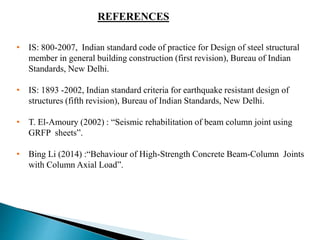PROJECT
- 1. SEISMIC BEHAVIOUR OF BEAM COLUMN JOINT USING HIGH STRENGTH MATERIAL STUDENT NAME : UDIT KUMAR ROY M.TECH STRUCTURES Department of Civil Engineering Amity School of Engineering & Technology Amity University Noida
- 2. CONTENTS • Introduction • Literature survey • Objective • Methodology • Schedule of work • References
- 3. INTRODUCTION • Beam-column joint is the zone of intersection of beams and columns which enables the adjoining members to develop and sustain their ultimate capacity. The joints should have proper adequate strength and stiffness to resist the internal forces induced by the framing members. • In a frame three types of joints can be identified:- 1) Interior joint. 2) Exterior joint. 3)Corner joint
- 4. REINFORCED CONCRETE JACKETING • Jacketing is most widely used techniques to strengthen RC columns. The main objective is to increase the seismic capacity of the structure. It will also increases the axial strength, bending strength, stiffness and ductility of the structure. • Jacketing was generally used in moment resisting frame structure. The column as well as beams of the existing structure were jacketed.
- 5. Seismic Behaviour of Beam Column joints • During Earthquake, the beam adjoining a joint are subjected to moment in same direction (clockwise and anticlockwise direction). Due to this moment the top bars in the beam column joint are pulled in one direction and the bottom bars are in the opposite direction. • If the column is not wide enough or the strength of concrete in the joint is low, there will be an insufficient grip of concrete on the steel bars. So the bars slips inside the joint region and loses the capacity to carry loads. • Due to above pull and push forces in the bars, the length of the joints elongates diagonally. Hence if the column cross section size is insufficient, diagonal cracks occurs in the concrete.
- 6. • In order to avoid diagonal cracks, a large column size is more effective or steel ties are also provided which are commonly known as “Stirrups”.
- 7. LITERATURE SURVEY • T. El-Amoury (2002) : Seismic rehabilitation of beam column joint using GRFP sheets • This paper investigates that steel plates were anchored to the beam bottom face at each side of the joint and connected together using threaded steel rods driven through the column. The idea is to replace the inadequately anchored steel bars with equivalent steel plates. • Steel-plate jacketing was used to enhance the joint shear strength. Test results showed that joint jacketing was ineffective in improving the joint shear strength due to slippage of the steel plates . • This scheme was found to be efficient in preventing the bars’ slippage, increasing the joint shear strength and reducing the rate of strength deterioration.
- 8. • Bing Li (2014) : Behaviour of High-Strength Concrete Beam-Column Joints with Column Axial Load • This paper presents findings of high strength concrete (HSC) interior beam- column joints under column axial compressive loading. Eight full-scale interior beam-column joints with varying degrees of reinforcement detailing were subjected to a constant column axial compressive load and quasi-static horizontal cyclic load. • The test revealed that HSC improved the bond condition of bars with a larger diameter due to the higher achievable bond stress, thereby allowing the use of longitudinal beams of a larger diameter. • The study confirmed that reinforcement of larger diameter can be used in HSC beams with the improvement in the bond condition. The presence of axial compressive load improved the bond stress of HSC beam-column joint but a threshold limit should be applied.
- 9. OBJECTIVE • The aim of this project is to study the Seismic Behaviors of Beam Column joint using Different types of High strength materials. • To Find best suitable method which can be less time consuming and can give more accurate result.
- 10. METHODOLOGY • Selection of Codes which follow earthquake design in construction. • Finding the various load on Beam Column Joint i.e. Dead load, Live Load, Seismic Load. • Calculating seismic force as per various proposed and existing codes. • Finding the most efficient method for seismic force Calculation act on Beam Column Joint.
- 11. Elevation Of Beam Column Joint :
- 12. SCHEDULE OF PROJECT COMPLETION Sr No Jan 2016 Feb 2016 Mar 2016 Apr 2016 May 2016 Status Completed Progress To be Done To Be done To be done 1 Problem Formulation Literature collection 2 Literature collection Calculation of Dead Load, Live Load 3 Software learning Modeling in software 4 Manual Calculations Validation of manual calculations Result & comparison Thesis writing 5 Thesis writing Publication 6 Seminar Viva
- 13. REFERENCES • IS: 800-2007, Indian standard code of practice for Design of steel structural member in general building construction (first revision), Bureau of Indian Standards, New Delhi. • IS: 1893 -2002, Indian standard criteria for earthquake resistant design of structures (fifth revision), Bureau of Indian Standards, New Delhi. • T. El-Amoury (2002) : “Seismic rehabilitation of beam column joint using GRFP sheets”. • Bing Li (2014) :“Behaviour of High-Strength Concrete Beam-Column Joints with Column Axial Load”.













